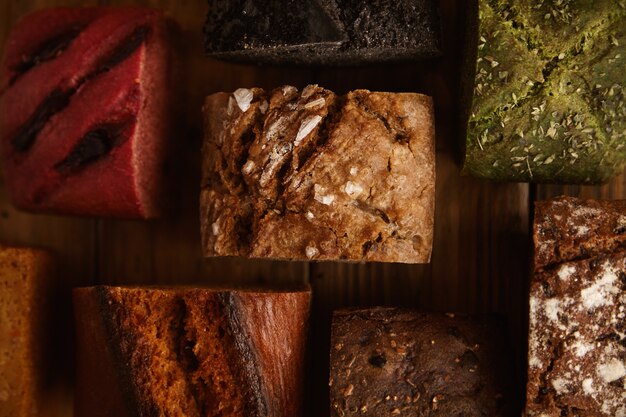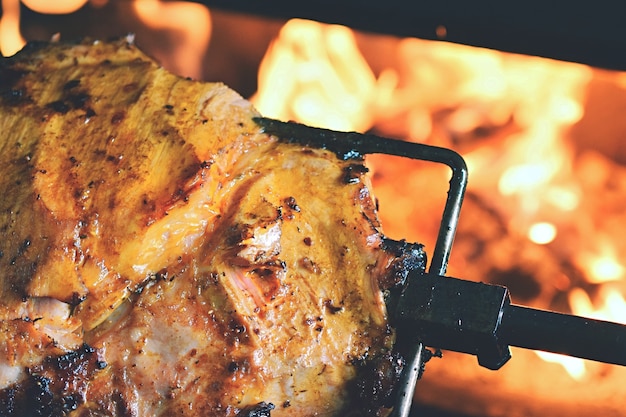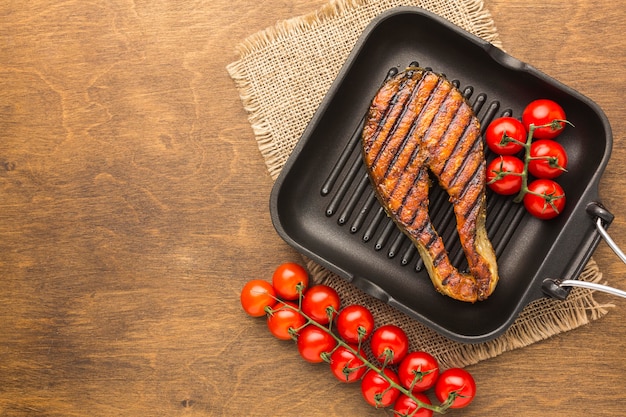There's a certain magic that happens when you sink your teeth into a perfectly cooked rack of ribs. The meat, tender and succulent, practically melts in your mouth, while the smoky, tangy sauce coats your taste buds in pure bliss. Achieving this culinary masterpiece, however, takes more than just tossing ribs into the oven and hoping for the best. It's about understanding the science behind rib cooking, knowing the right oven temperature, and mastering a few key techniques.
Over the years, I've spent countless hours in the kitchen, experimenting with different methods and recipes. I've had my fair share of dry, tough ribs, leaving me disappointed and craving for something more. But I've also had moments of pure rib-cooking ecstasy, where every bite was a symphony of flavor and texture. These experiences taught me that the perfect oven temperature is the cornerstone to achieving that melt-in-your-mouth tenderness that makes ribs so irresistible.
(Part 1) The Science of Oven Temperature and Ribs

To truly understand how oven temperature impacts rib cooking, we need to delve into the science behind it. Ribs are essentially large cuts of meat, rich in connective tissue. This tissue, while adding flavor, can make the meat tough and chewy unless properly cooked. Our mission, then, is to break down that connective tissue, transforming it into gelatin, the key to achieving that melt-in-your-mouth tenderness we crave.
Low and Slow: The Secret to Tenderness
This magic happens through the process of low and slow cooking. Imagine trying to soften a piece of leather. You wouldn't blast it with a blowtorch, would you? No, you'd gently apply heat over a long period. That's the same concept we apply to ribs. low and slow cooking allows the heat to penetrate the meat gradually, gently breaking down that tough connective tissue into the delicious gelatin that makes ribs so tender.
High temperatures, on the other hand, simply cook the meat quickly, leaving the connective tissue tough and chewy, resulting in a disappointing rib experience. So, think of low and slow cooking as a gentle massage for your ribs, allowing them to relax and become luxuriously tender.
(Part 2) The Magic Number: 275°F (135°C)

Based on years of experimentation and countless recipe trials, I've found that 275°F (135°C) is the sweet spot for oven-cooked ribs. This temperature allows for slow, even cooking, breaking down connective tissue without drying out the meat. It's a balance that creates a symphony of flavor and texture, leaving you with ribs that are both tender and flavorful.
Of course, every oven and every rack of ribs is different. Factors like the size of the ribs, the type of oven you have, and even the humidity in the air can all play a role. But 275°F is an excellent starting point. Feel free to adjust the temperature slightly based on your specific needs and preferences.
(Part 3) The Importance of Preheating

You might be thinking, "Alright, 275°F, got it. But what about preheating?" Preheating is crucial for consistent cooking results and, frankly, it's the difference between a successful rib cooking experience and a culinary disaster.
Think of it this way: you're throwing a party. You've got the decorations, the cake, and your guests are about to arrive. But then you realize you haven't preheated the oven for the party snacks! The food takes longer to cook, and you end up with a party that's a bit of a disaster.
The same goes for ribs. If you put them in a cold oven, the meat cooks unevenly, leaving some parts overcooked and others still raw. Preheating ensures that the oven is at the desired temperature from the moment the ribs go in, resulting in consistent cooking and perfect results.
So, always preheat your oven to 275°F for at least 30 minutes before you put the ribs in. It's a small step that makes a big difference in achieving perfectly cooked ribs.
(Part 4) The Role of the meat thermometer
Time and visual cues can be deceiving when it comes to rib cooking. You need a trusty meat thermometer to ensure your ribs reach the perfect internal temperature for that melt-in-your-mouth texture. Relying solely on time or how the ribs look can lead to disappointment.
The USDA recommends an internal temperature of 145°F (63°C) for safe consumption. But for those fall-off-the-bone, unbelievably tender ribs, aim for 190°F (88°C). This higher temperature ensures that the connective tissue is completely broken down, resulting in ribs that are practically begging to be devoured. It's a culinary commitment that guarantees a truly satisfying rib experience.
(Part 5) Timing Is Everything
While the ideal oven temperature is crucial, timing plays a significant role in achieving perfectly cooked ribs. The amount of time you cook them depends on various factors, including the size of the rack, the cut of meat, and the level of tenderness you desire.
General cooking time: A Starting Point
As a general rule of thumb, you can expect to cook ribs at 275°F for about 3-4 hours for baby back ribs and 4-5 hours for spare ribs. However, remember that this is just a starting point. The key is to use your trusty meat thermometer to ensure the ribs reach that perfect internal temperature of 190°F (88°C).
Don't be afraid to adjust the cooking time based on your ribs and your oven. Some ribs might need a little more time to achieve the desired tenderness, while others might cook faster. Remember, you are the conductor of your rib-cooking symphony, and your meat thermometer is your guide.
(Part 6) The Wrap Method: A Secret Weapon for Tender Ribs
One of my favorite techniques for achieving melt-in-your-mouth ribs is the wrap method. It's a simple yet powerful technique that adds another layer of tenderness and moisture to your ribs, making them truly irresistible.
The secret lies in the steamy environment created by the foil. This steam gently breaks down the remaining connective tissue, adding to the overall tenderness. It also prevents the ribs from drying out, ensuring they stay juicy and flavorful.
How to Wrap Ribs in Foil: A Step-by-Step Guide
Here's how to do it:
- Once the ribs have been cooking for 2-3 hours, remove them from the oven.
- Place a large sheet of heavy-duty aluminum foil on a flat surface.
- Sprinkle the ribs with a generous amount of your favorite barbecue sauce. (More on sauce later!)
- Fold the foil over the ribs, sealing the edges tightly to create a steam-filled packet. Think of it like a warm, comforting hug for your ribs.
- Return the wrapped ribs to the oven and cook for another 1-2 hours.
- After the ribs are done, remove them from the oven and let them rest for 15-20 minutes before unwrapping. This allows the juices to redistribute throughout the meat, ensuring maximum tenderness and flavor.
The wrap method is a game-changer for rib cooking. It's a simple technique that elevates your ribs from good to truly outstanding.
(Part 7) The Art of Saucing
No rib experience is complete without a delicious barbecue sauce. The perfect sauce can transform your ribs from good to unforgettable. I recommend using a sauce that's smoky, sweet, and tangy, with a balance of flavors that complements the meat without overpowering it. It's a delicate dance of flavors that culminates in a truly satisfying rib experience.
Timing is crucial when it comes to sauce. It's best to apply the sauce during the last hour of cooking, allowing it to caramelize and create a delicious crust. You can also brush the ribs with sauce a few times during the final stages of cooking to create layers of flavor.
However, be mindful of the sugar content in the sauce, as it can burn easily at high temperatures. If you're using a sauce that's high in sugar, it's best to apply it only during the last 30 minutes of cooking. You don't want to risk burning the sauce and ruining the delicate flavor profile of your ribs.
Experiment with different barbecue sauces to find your perfect match. There's a world of flavor out there waiting to be explored, from classic smoky sauces to tangy vinegar-based sauces. It's a delicious journey of discovery.
(Part 8) Ribs on the Grill: A Delicious Alternative
While oven cooking is my preferred method for ribs, grilling them can also be an excellent option, especially during the summer months. The smoky flavor imparted by the grill adds another dimension to the ribs, making them even more irresistible. It's the perfect way to enjoy the outdoors while indulging in delicious, smoky ribs.
grilling ribs: Maintaining the Right Temperature
The key to grilling ribs is to maintain a consistent, low temperature, just like you would in the oven. Aim for a grill temperature between 250°F and 300°F (121°C-149°C). This low and slow cooking method will allow the ribs to tenderize and develop a beautiful bark, that crispy outer layer that's so satisfying to bite into.
Use a grill thermometer to monitor the temperature, adjusting the vents as needed to maintain the desired range. Remember, patience is key when grilling ribs. The slower you cook them, the more tender and flavorful they will become.
(Part 9) FAQs
1. Can I Use a Convection Oven to Cook Ribs?
Absolutely! Convection ovens use a fan to circulate hot air, which can speed up the cooking process. If you’re using a convection oven, I recommend reducing the temperature by 25 degrees F (14°C) to prevent overcooking. So, instead of 275°F, you’d cook the ribs at 250°F. This adjustment ensures that the ribs cook evenly without drying out.
2. Should I Use a Meat Thermometer for Grilling Ribs?
Yes, absolutely! While grilling ribs can be a bit more hands-on, using a meat thermometer is still essential to ensure they're cooked through. The temperature should be at least 145°F (63°C) for safety, and for those incredibly tender ribs, aim for 190°F (88°C). Don't rely on visual cues alone; use your meat thermometer to be sure.
3. What If My Ribs Are Too Dry?
If your ribs are dry, it's likely that they were cooked for too long at too high a temperature. The best way to combat dryness is to add moisture. You can do this by wrapping the ribs in foil for the last hour of cooking, or by basting them with sauce. This will help to trap in the moisture and prevent the ribs from drying out.
4. How Do I Make Ribs More Flavorful?
There are many ways to add flavor to ribs. You can rub them with a dry rub before cooking, baste them with sauce during cooking, or even marinate them overnight. A dry rub adds a delicious crust to the ribs, while a sauce adds a rich, tangy flavor. Marinating the ribs overnight infuses them with deep, delicious flavor.
Experiment with different herbs, spices, and sauces to find your favorite flavor combinations. From classic rubs with paprika and garlic to more exotic blends with ginger and chili, the possibilities are endless.
5. Can I Cook Ribs in the slow cooker?
Yes, slow cookers are a great option for cooking ribs, especially if you don’t have a lot of time. The slow cooker does a fantastic job of tenderizing the meat and breaking down the connective tissue. Simply place the ribs in the slow cooker, add your favorite sauce, and cook on low heat for 6-8 hours or on high heat for 3-4 hours.
The slow cooker's gentle heat creates a moist environment that helps to tenderize the ribs and infuse them with flavor. It's a great option for busy cooks who want to enjoy delicious ribs without spending hours in the kitchen.
Remember, cooking ribs is a journey, not a race. Embrace the process, experiment with different techniques, and most importantly, have fun! Every time you cook ribs, you're creating a culinary masterpiece, a symphony of flavors and textures that will leave you wanting more. So, grab your favorite sauce, fire up the oven, and let the rib-cooking magic begin!
Everyone is watching

How to Cook Frozen Lobster Tails Perfectly: A Step-by-Step Guide
RecipesLobster. Just the word conjures up images of lavish meals, special occasions, and a taste of luxury. But let's...

Pigs in a Blanket Cooking Time: How Long to Bake for Perfect Results
RecipesAh, pigs in a blanket. Just the name conjures up images of those delightful little parcels of crispy pastry en...

Pork Fillet Cooking Time: How Long to Cook It Perfectly
RecipesPork fillet, or tenderloin as it's sometimes called, is a real favourite in our house. It's so versatile, and...

The Ultimate Guide to Cooking Sweet Potatoes: From Roasting to Mashing
RecipesSweet potatoes. Just the name conjures up images of warm, comforting dishes, bursts of vibrant color, and a to...

The Ultimate Guide to Tender, Juicy Pulled Pork
RecipesRight, let's talk pulled pork. It's one of those dishes that just screams "comfort food," doesn't it? I mean...
